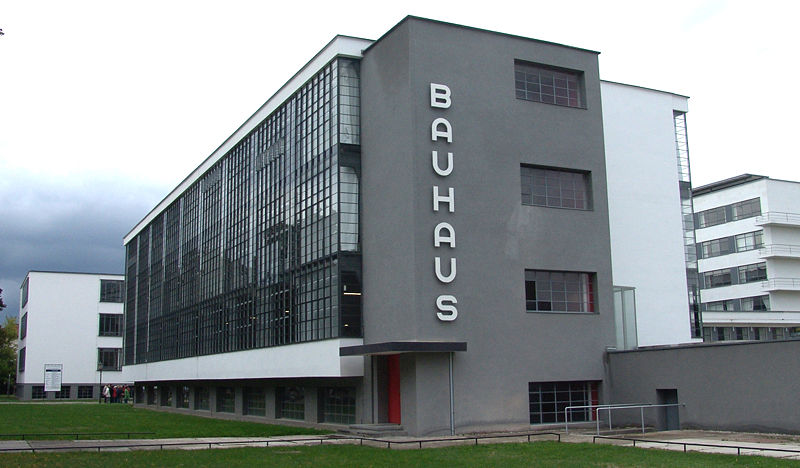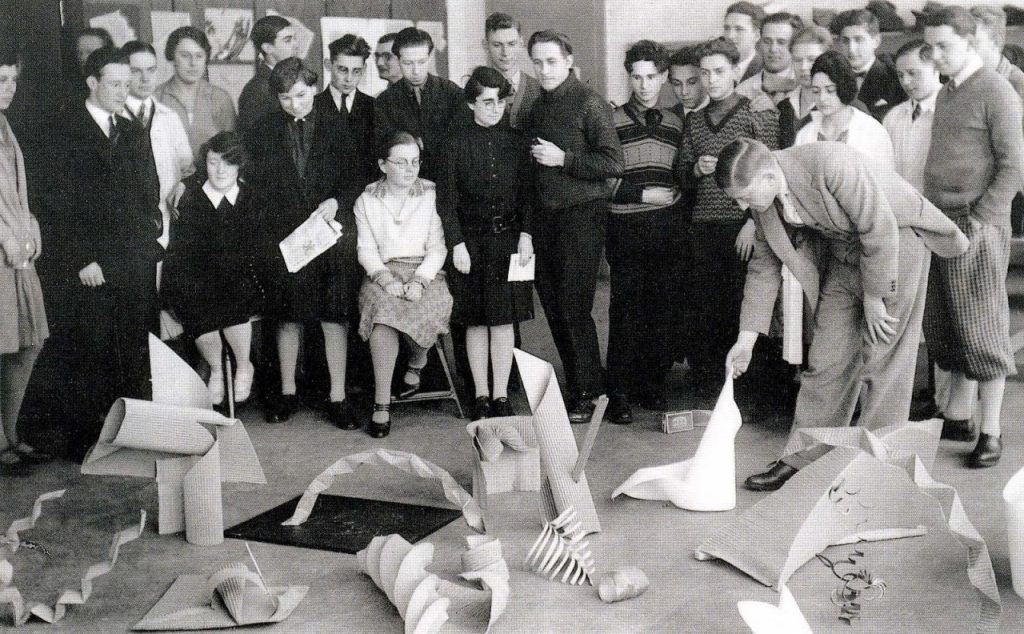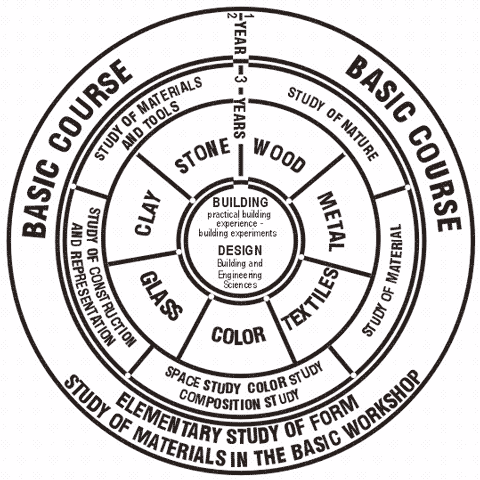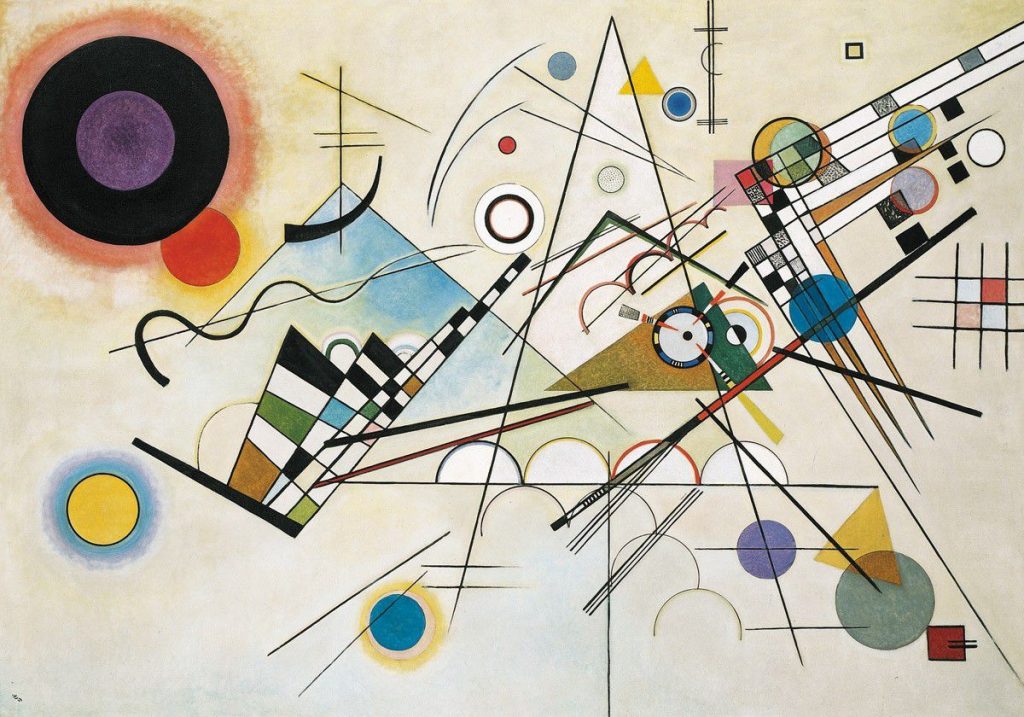Issue 5: Reality?
Bauhaus and Code: A Tutorial Essay for the Digitally Alienated
Bauhaus and Code: A Tutorial Essay for the Digitally Alienated
By Davíd Raphael Lockard
Save humanity by messing around? 100 years after its founding, the Bauhaus school’s radical ideas on engaging with new tech are more useful than ever. A hands-on look at their use of playful experimentation.
“Cooks know very little about cooking, and tailors don’t know a thing about clothes… for the exact same reason why portrait painters paint the worst portraits. The narrow specialty which is their entire lives is what robs them of the very meaning of that speciality, and they always confuse the important with the trivial… Let us use all our possible means to stop the flood of garbage that surrounds us.” – Gustave Flaubert
2019 marks a hundred years since the founding of the Bauhaus school in Germany. There are many reasons to look back at the work of that institution today: among them is the possibility that current concerns about emerging technologies bear strong parallels to questions that informed the founding of the Bauhaus.
The first half of this article explores the applicability of the Bauhaus pedagogy of hands-on, interdisciplinary experimentation for contemporary struggles to shape healthy relationships to new digital technologies.
The second half diverges from the essay style, taking the form of a hands-on coding tutorial for readers who have never tried to code before – and who, importantly, enjoyed the piece’s first half. It is meant to be casual and welcoming, and is based on the writings of painter and Bauhaus teacher Vasily Kandinsky.
Taken together, this framework seeks to demonstrate the power of lifelong playful learning in the struggle to feel grounded within shifting technological realities.
This piece was developed for a presentation with Mathura Govindarajan at the Bauhaus Dessau Foundation’s centenary festival School Fundamental

Spirit of the Age
Concerns about technological advances precipitating a collapse in morality, humanity, and users’ ability to live full lives have been with us since (at least) the invention of writing(1). Expressions of such concern, viewed in retrospect, are often used in our search for cohesive narratives that will explain ‘the spirit’ of a given age.
The Bauhaus was in many ways a product of a society seeking to find balance between the affordances and dangers of new technologies. Europe’s inter-war atmosphere, in which the school was formed, was deeply marked by fears that new modes of industry were robbing humanity of a fundamental attachment to its surroundings. Such fears were a defining cultural force even before the shock of WWI further cemented the widespread idea that industrial automation posed a severe threat to humanity’s underlying values. The Bauhaus would come to be defined by its ambition to avert this threat, proclaiming its intention to fix the relationship between man and machine by equipping its students with the skills and mindset needed to construct a material reality that provides a moral check on industrialism gone wild.

The school would do so through embracing the possibilities offered by technological advances, rather than retreating from them(2). Instead of scorning mass production – as craft workers and guilds of the time were often inclined to – the Bauhaus would harness industrial production in its aim to “eliminate every drawback of the machine without sacrificing any one of its real advantages,” in the words of founder Walter Gropius.
Constructing Engagement
It seems reasonable to suggest that the spirit of our age, too, will one day be looked back upon as deeply defined by widespread societal fears of technological upheaval. We are inundated with reports on the political and psychological damage of social media, the weaponization of data, and the imminent obliteration of entire job markets due to advances in robotics and AI.
Few would maintain that the shaping of norms and policies relating to new tech is best entrusted to those whose livelihood is tied to the tech industry’s current dominant modes of growth. But the wider public’s ability to formulate nuanced positions on tech-related topics is hampered by a sense that these topics are much too complex.
A recent spate of reports about individuals physically attacking self-driving cars is a symbolic reminder of the historic pattern(3) in which new technologies put to the service of a small minority often lead to reactionary coping strategies, instead of to creatively engaging with the newfound possibilities these advances may afford. Meanwhile the findings of the Moral Machine, MIT’s crowd-sourced survey on attitudes towards self-driving cars shows the value of successfully engaging the wider public in policy debates.
From an educational perspective, one way in which the digital machines of today differ starkly from the steam engines and mechanical looms that dominated the thoughts of early 20th century educators, is that they allow wide opportunities for self-learning.

Oskar Schlemmer 1921
In deep contrast to Bauhaus-era machines, our digital tech contains within itself traits that lend themselves well to the promotion of wider engagement. Firstly, our computers – as anyone who has used one knows – are deeply flexible tools that carry within themselves an amazing capacity to be reshaped and used in a vast variety of ways by their users. Secondly, computers with keyboards can today be found in over 90% of American households(4). And thirdly, our computers provide their users (given access to open network) with connections to a vast possibilities of self-education as to how to manipulate them.
None of this could be said about the cotton gin, of course. And while broad comparisons like this risk leading to reductionist readings – such comparisons may be useful as we attempt to distill which parts of a past approach to new technology may be still applicable.
These three facets of the digital reality we are so deeply immersed in are particularly poignant when one considers the well-known fact that for most of us, gaining actual hands-on experience in any given field of activity or knowledge may dramatically deepen our ability to relate to matters surrounding it.
It would be correct to note that coding experience is by no means a prerequisite for developing an informed opinion about moral, economical, or political questions relating to tech. Framing a technically complex topic such as, say, algorithm bias, in terms clear to an interested non-coder is an important service of tech journalists, and many do it well.
Regardless, it would be a mistake to underestimate the huge impact even limited exposure with actual experience can have. Just as trying one’s hand at oil painting – even once – will almost inherently lead to a deeper appreciation of painting, and the experience of casting a vote will most likely deepen one’s grasp of democracy – so an actual hands-on experience coding will often deeply impact ones attitude to matters relating to computers.
There exists, of course, an incredible abundance of accessible, high quality tutorials, resources and tools designed especially for beginners. Thus, those interested in promoting a wider engagement with tech may find it tragic that despite the large amounts of free time most of us spend on screens, very few (who have no functional need to do so) will devote any of it to trying their hand at coding.
In looking at ways to welcome more non-coders to try it for the first time, the Bauhaus pedagogy may prove a useful source to revisit.
Breaking Down Separations
Today, one’s first introduction to the school is often via the term ‘Bauhaus style,’ used to describe sleek, geometrical buildings, graphics and products with little ornament. Gropius would later express frustration with the term, adamantly describing the school not as a factory for forging a specific aesthetic, but rather a place of constant reinvention directed at forging a comprehensive, humanistic answer to the challenges of technological alienation; a place where students would grow into radical agents of a new humanity(5). The Bauhaus, Gropius wrote, deliberately concentrated primarily on what has now become a work of paramount urgency: to avert mankind’s enslavement by the machine by giving its products a content of reality and significance, and so saving the home from mechanistic anarchy.
How successful the Bauhaus was in advancing this lofty goal is debatable and well beyond the scope of this text. What does seem more evident is that the school’s innovative pedagogical focus on hands-on interdisciplinary experimentation would have a deep impact on the way creative disciplines are taught until today.

A key concept for the advancement of the Bauhaus’ aims was the school’s conception of ‘a common citizenship of all varieties of creative work(6).’ At the very beginning of the Bauhaus manifesto, Gropius describes the school’s aim to “reunify all the disciplines of practical art… as inseparable components of a new architecture.” This idea is a continuation of the work of the school’s predecessors in the German Werkbund and the British Arts and Crafts Movement, who lay the foundations for eliminating the borders defining creative disciplines, and reevaluating crafts workers’ relationship to modern modes of industry and commerce.
This aim of ‘reunification’ was famously implemented in the school’s vorkurs, or preliminary course – a two-term obligatory class for all new students, which endured through the school’s various permutations and came to be a defining feature of its legacy. The class positioned what today we might call playfulness as a foundational tool for students’ creative development. In the words of Laszlo Moholy-Nagy, the Bauhaus teacher who led the school through its most overtly ‘tech-oriented’ phase, the objective of the vorkurs was “spontaneity and inventiveness, to show the student the way to a universal outlook, to make him conscious of his creative power. The method is to keep in the work of the grown-up the sincerity of emotion, the truth of observation, the fantasy and the creativeness of the child(7).”

The fact that today, most graduates of creative academies are likely to view such notions as quaint may attest to the impact of the vorkurs approach. Contemporary ‘foundational classes,’ a staple of art and design schools worldwide, are directly modeled after the vorkurs. Academies that stick to older models of strict discipline separation are often regarded as outmoded.
But as the cannonification of a ‘Bauhaus style’ suggests, replication of form can lead to confusion over when it is motivated by a wish to do just that – replicate form – and not by a wish to truly engage with the underlying principles which led to that form.
Beyond Specialization
The rising importance of digital literacy is not going unnoticed by educational policymakers and parents, who are overseeing the prioritization of programming skills in classrooms. This tendency, aimed at improving students’ ability to fit into developing job markets, fits well into the fashionable discourse of ‘creative problem-solving’ pedagogies.
But the humanistic ring of ‘creativity’ may be misleading. As Claire Bishop points out in her book Artificial Hells – Participatory Art and the Politics of Spectatorship (8), current tendencies in participatory creative education are often motivated by an acceptance of an increasingly atomized society in which even minimal social safety nets are done away with, and each citizen must ‘problem solve’ for themselves.
Echoing Flaubert’s qualms about the ability of professional portrait painters to paint good paintings, I would suggest that a wider range of responses to questions surrounding tech is unlikely to be driven by simply training more specialists. Rather, it will be propelled by generating more nuanced conversations among people who are immersed in other fields.
And it is here we return to the heart of Moholy-Nagy’s writing about the vorkurs, where he presents the holistic view on creative education that informed the Bauhau’s Dessau phase. He highlights the losses assumed by a society that prioritizes specialization above all else and thus neglects wider connections to ones surroundings and oneself.
“In the frenzied march of the industrial revolution, the industrialists set up specialized schools to produce quickly the badly-needed specialists. These schools favored the development of men’s powers only in very few instances, and offered no opportunity to penetrate to the essential kernel of things and the individual himself. But- to tell the truth – no one concerned himself with this because no one could foresee its destructive results. Today neither education nor production springs from an inner urge, nor from an urge to make products which satisfy the requirements of one’s self and those of society in a mutually complementary way.”
Specialists under the current system, he writes, are “like members of a powerful secret society – obscure the road to all sided individual experiences,the possibility for which exists in [a person’s] normal functions, and the need for which arises from the center of [their] being… the ‘market demand’ is the guide.”
Coding Kandinsky

With that in mind, let us return to the point made earlier that even a small amount of positive, actual experience is likely to raise the chances of further engagement with any topic – and also the ability to constructively converse with those who regularly do.
One would be correct to question exactly how much impact a brief exposure to coding would, in itself, have on any non-coder’s engagement with topics such as net neutrality or a loss of privacy. That’s true, of course – but one would be amiss to dismiss the immense value of first steps.
How can we best shape self-directed, positive code-learning opportunities for adults who are busy leading lives that do not involve coding? By forging opportunities designed to help learners grow horizontally into new fields of learning and enjoyable engagement. One way is by relating this vast and mutable field to pre-existing interests. Especially for something with its own, intimidating logic such as code, there is value in relating it to a learner’s pre-existing interests, and meeting them where they are.
This point in itself would be best demonstrated hands-on. Which is why, without you having to go anywhere or download anything, we will now embark on an introductory coding tutorial, designed to provide you with a hands-on grasp of some basic elements of coding.
I believe where you are, right now, is at the bottom of a text about the Bauhaus. I don’t know much else about you – but if you have read until here it may be safe to assume that you have some interest in the topic of the Bauhaus, and are not averse to long-winded texts. Which is why, perhaps, my best shot will be through a textual tutorial that relates to the topic at hand.
“The investigation should proceed in a meticulously exact and pedantically precise manner. Step by step, this “tedious” road must be traversed — not the smallest alteration in the nature, in the characteristics, in the effects of the individual elements should escape the watchful eye.” (p.21)
The Environment
The grey window below is an editor, in which one can both write and execute programs.
Notice it is divided into two panels. Code is written on the left and executed on the right. Think of the left panel as a place to write a recipe – and the right panel as where the dish appears. The editor window above is empty, but the next ones will have code that you can modify.
Notice it is divided into two panels. Code is written on the left and executed on the right. Think of the left panel as a place to write a recipe – and the right panel as where the dish appears. The editor window above is empty, but the next ones will have code that you can modify.
Select and copy the following italic text into the left side panel of the editor above, and then hit play:
createCanvas(400,200)
background(0,0,0)
fill(255,255,255)
rect(100,40,20,20)
rect(200,40,20,20)
rect(160,80,20,20)
rect(130,130,120,20)
Congrats! Let’s move on to Part II, where we will learn what these lines mean.
1. See Socrates: Writing vs. Memory for more
2. Most notably during its Dessau phase, 1925-32
3. For more on such ‘Luddist’ reactions
4. https://www.statista.com/statistics/214641/household-adoption-rate-of-computer-in-the-us-since-1997/
5. Further reading at Rethinking the Utopian Vision of the Bauhaus / Turner
6. Gropius, Walter, The New Architecture and The Bauhaus. MIT Press, Pg 85
7. Moholy-Nagy, The New Vision: Fundamentals of Bauhaus Design, Painting, Sculpture, and Architecture. Courier Corporation, 2012
8. Bishop, Clair. Artificial Hells – Participatory Art and the Politics of Spectatorship. Verso, 2012. Full PDF
Davíd R. Lockard is a Jerusalem-based designer and educator interested in how we learn to learn. | davidlockard.net
